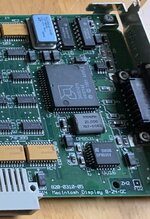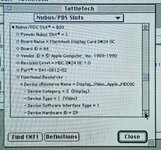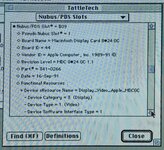In a number of cases the design was optimized for high performance over low cost. A good example of this is 32 bpp operation on Apple's standard 13-inch RGB monitor at 640 x 480 resolution (and this also applies to VGA and NTSC), which is probably the most common color monitor in use on the Macintosh. The actual number of memory bytes needed to support 24 bpp is 640 x 480 x 3 = 921,600. This would seem to fit within 1 MByte of memory (as is the case with the Apple 8*24 video card), but the Quadras actually require 2 MBytes of VRAM for this mode. The 8*24 card supports 24 bpp at 640 x 480 by using a storage mode called 'chunky planar' to fully utilize all its 1 MByte of VRAM. However, this results in having to perform 3 separate memory accesses for each 24-bit pixel read from or written to the frame buffer. (This is done in hardware so software only performs a single read or write.) On a NuBus video card, this inefficiency is partially masked by the synchronization delays which occur at the processor-bus/NuBus interface. However, when frame buffer memory is placed directly on the processor bus, this approach results in a nearly 3X performance degradation. This was judged unacceptable for the Quadras. Each 24-bit pixel occupies one longword (4-bytes) in VRAM, so the Quadras actually provide 32 bpp for the 640 x 480 resolution. This pushes the memory requirement for this mode over the 1 MByte boundary (640 x 480 x 4 = 1,228,800 bytes)








